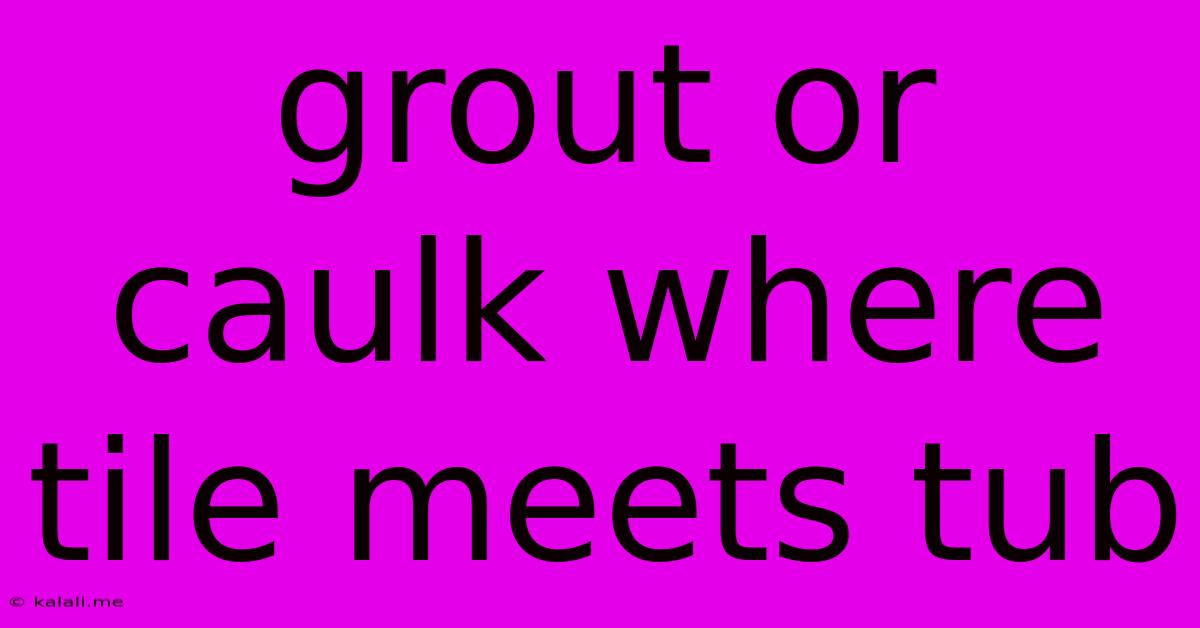Grout Or Caulk Where Tile Meets Tub
Kalali
Jun 03, 2025 · 3 min read

Table of Contents
Grout vs. Caulk: Sealing the Gap Where Tile Meets Tub
Choosing between grout and caulk for the crucial area where your tile meets your bathtub is a common dilemma for homeowners. This seemingly small detail significantly impacts the longevity and aesthetic appeal of your bathroom. This article will clarify the differences between grout and caulk, highlighting which is best suited for sealing the tile-to-tub joint and ensuring a watertight, beautiful finish. Understanding the pros and cons of each will empower you to make the right choice for your bathroom renovation or repair.
Understanding the Differences: Grout vs. Caulk
Both grout and caulk are used to fill gaps and seal surfaces, but they have distinct properties that make them suitable for different applications.
Grout: A hard, cement-based material, grout is primarily designed for filling the spaces between tiles. It offers strength and durability but is less flexible and prone to cracking when subjected to constant movement or expansion and contraction. Grout is also porous, meaning it can absorb water if not properly sealed.
Caulk: A flexible, rubber-based sealant, caulk is designed to accommodate movement and expansion. It creates a watertight seal, preventing moisture from penetrating behind the tiles and causing damage. Caulk is typically more resistant to cracking than grout and is available in a variety of colors to match your tile and grout.
Why Caulk is the Best Choice for Tile-to-Tub Joints
The area where your tile meets your tub experiences significant movement. The tub itself can shift slightly, and the tile and underlying substrate can expand and contract with temperature fluctuations. This movement is precisely why caulk is the superior choice.
- Flexibility: Caulk's flexibility allows it to accommodate this movement without cracking, preventing water from seeping into the wall cavity. This prevents mold and mildew growth, a common problem in bathrooms.
- Water Resistance: Caulk provides a superior watertight seal compared to grout, crucial in preventing water damage to the underlying structure.
- Durability (in this application): While grout can be durable in other applications, its rigidity makes it less suitable for high-movement areas like the tile-to-tub seam.
Applying Caulk Like a Pro:
Applying caulk correctly is essential to ensure a long-lasting and aesthetically pleasing seal. Here's a step-by-step guide:
- Preparation is Key: Thoroughly clean the joint, removing any old caulk, loose grout, dirt, or debris. Allow the area to dry completely.
- Smooth Application: Use a caulking gun to apply a smooth, continuous bead of caulk.
- Tooling: Use a wet finger or a caulking tool to smooth the bead, creating a neat and even finish.
- Cleanup: Wipe away any excess caulk immediately with a damp cloth.
Maintaining Your Caulk Seal:
Regular inspection and maintenance will extend the life of your caulk seal. Check the caulk periodically for cracks or gaps. If you notice any issues, remove the old caulk and reapply a fresh bead. This preventative maintenance will help prevent costly water damage and keep your bathroom looking its best.
In Conclusion:
While grout and caulk each have their uses, caulk is undeniably the best option for sealing the gap where tile meets your tub. Its flexibility, superior water resistance, and ability to withstand the movement inherent in this area make it the ideal choice for a durable, waterproof, and aesthetically pleasing finish. Choosing the right sealant is a critical step in maintaining a healthy and beautiful bathroom.
Latest Posts
Latest Posts
-
Fell Asleep With Blanket Covering Face
Jun 05, 2025
-
What To Call Both Tv And Movie
Jun 05, 2025
-
What Year Was Pauls Testimony To Agrippa
Jun 05, 2025
-
Is The Prince Of Egypt Accurate
Jun 05, 2025
-
How Long The Application Will Abandon After Receiving Adisory Action
Jun 05, 2025
Related Post
Thank you for visiting our website which covers about Grout Or Caulk Where Tile Meets Tub . We hope the information provided has been useful to you. Feel free to contact us if you have any questions or need further assistance. See you next time and don't miss to bookmark.